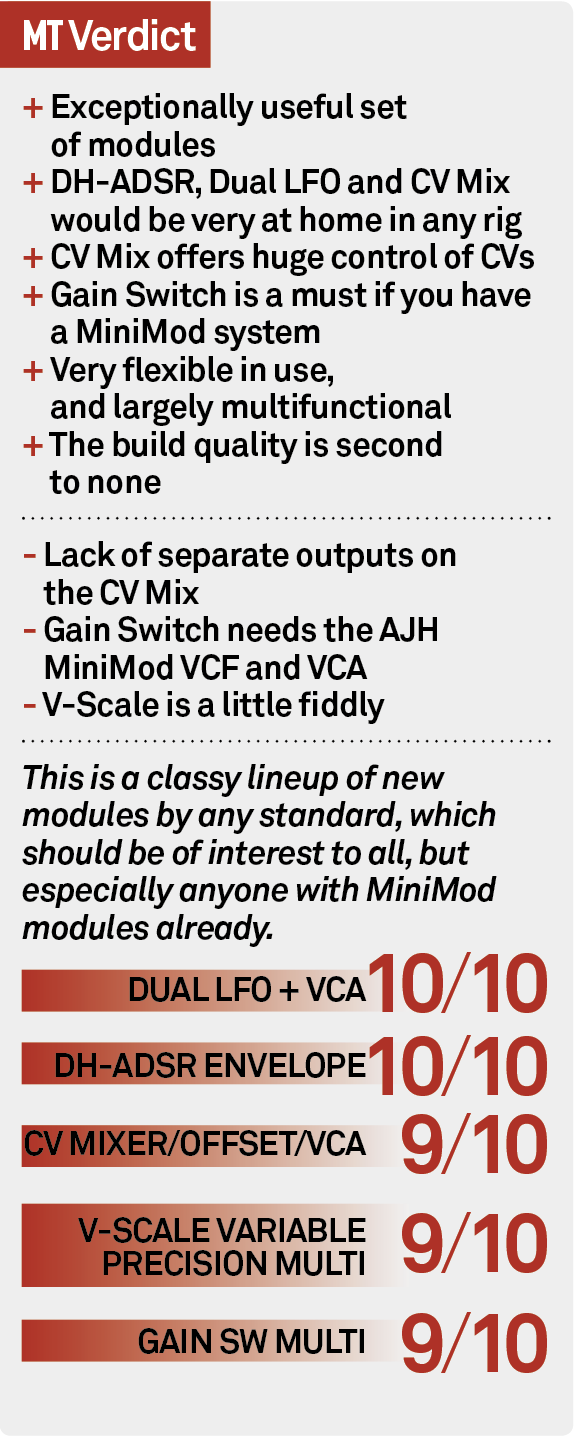2017 AJH Synth MiniMods Review – A Classy Lineup
AJH Synth surprised us recently at NAMM 2017 with the release of five new utility-type MiniMods. Dave Gale gets his hands on this latest crop of exceptionally useful modules… Details Manufacturer AJH Synth Price Available in black/silver Dual LFO + VCA: £210/£195, DH-ADSR Envelope: £210/£195, CV Mix-Offset-VCA: £155/£145, V-Scale Variable Precision Multi: £105/105, Gain Switch […]

AJH Synth surprised us recently at NAMM 2017 with the release of five new utility-type MiniMods. Dave Gale gets his hands on this latest crop of exceptionally useful modules…
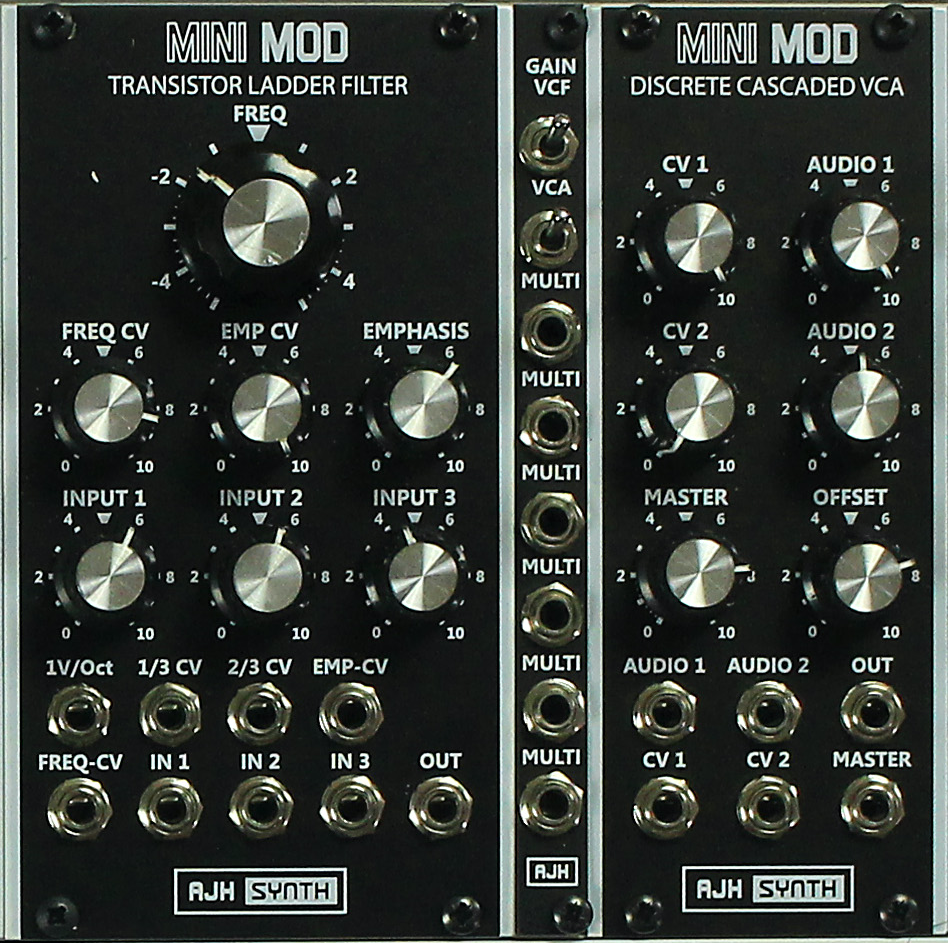
Details
Manufacturer AJH Synth
Price Available in black/silver Dual LFO + VCA: £210/£195, DH-ADSR Envelope: £210/£195, CV Mix-Offset-VCA: £155/£145, V-Scale Variable Precision Multi: £105/105, Gain Switch Multi: £70/£70
Contact 07867 008694
sales@ajhsynth.com
Web www.ajhsynth.com
![]()
AJH Synth’s reputation has been completely sealed over the last year or so, not only with the enormous popularity of the exceptionally fine MiniMod system (reviewed MT156), but also with some further additions last year in the shape of the Sonic XV filter and Ring SM ring mod and sub-oscillator module, which were both a credit to the product line. Allan Hall, who is the creative genius behind AJH, is never a person to stand still, and I’ve always had this feeling he’s been beavering away in the background, working out how to improve both the feel and functionality of his products – as though being hand-made in the UK, with weapons-grade parts, wasn’t enough. So here we have five new modules, all of which have something to offer either the existing MiniMod system, or can stand alone in a crowded modular and fight their corner.
Dual LFO + VCA

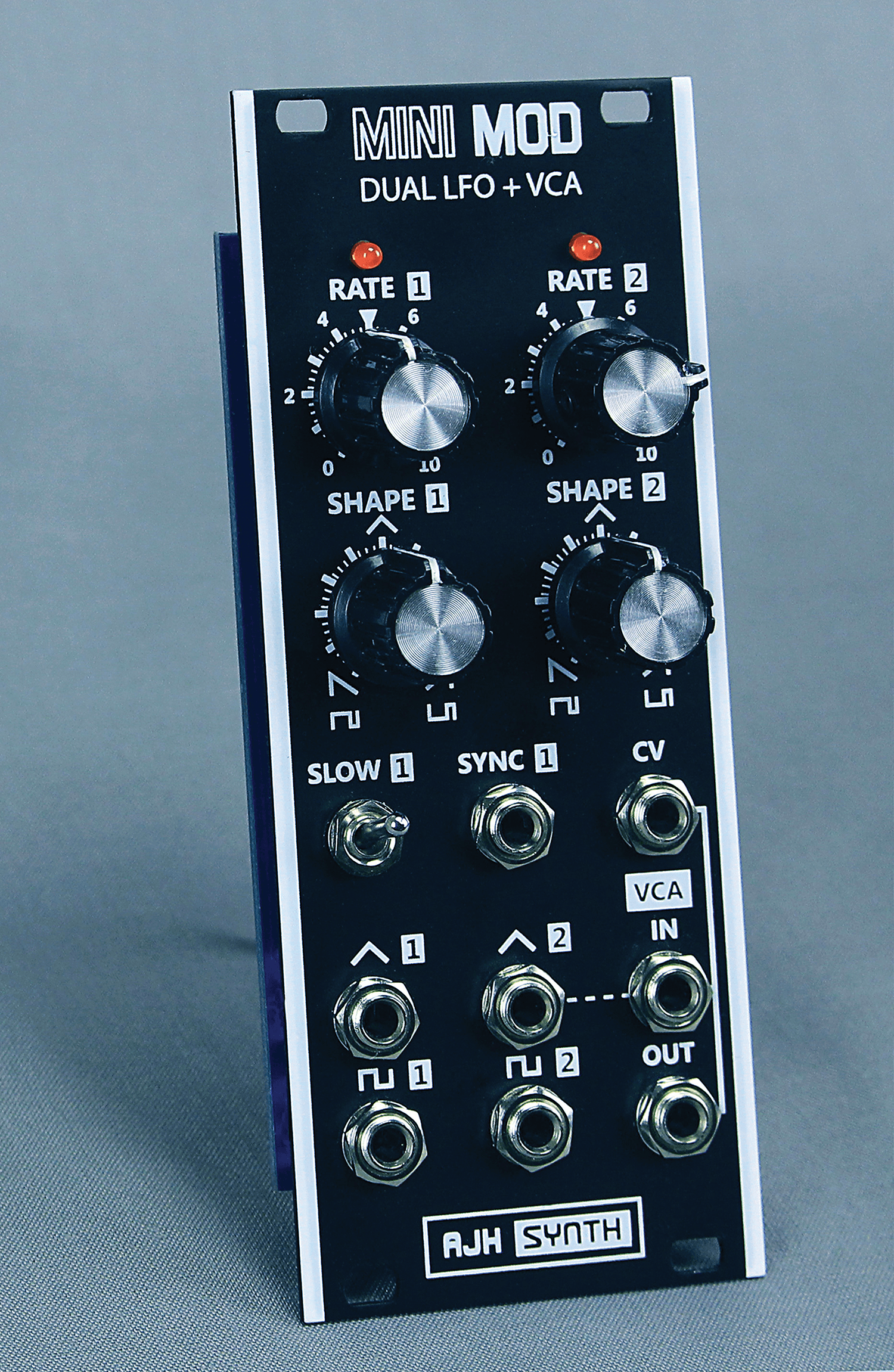
It’s my belief that every Eurorack rig should have at least one free-flowing LFO, as it’s so useful to have an element that can be set to modulate away from the clock pulse, without any relationship whatsoever. So having two free-flowing LFOs is a positive boon, but that’s just the beginning! Labelled very clearly, LFO 1 and LFO 2 have separate controls of rate, as well as shape, with dual outputs for both, that offer either Triangle-to-Saw-based waveforms from one source output, and Square/Pulse-like waves from the other. This means it’d be entirely possible to use the Pulse-based outputs as a form of sync Pulse, locking things together nicely, although AJH has included a Sync input on LFO 1, which will happily restart your chosen wave with a
Pulse from elsewhere.
“A Slow switch offers very long LFO sweeps in the range of 0.5 seconds to 100 seconds”
The wave controls themselves sweep from either upward Saw ramp, through to Triangle and on to a downward Saw ramp, or via the second output, Pulses and Squares can be derived, in various incarnations. The rate of these waves is applied via dedicated rate pots, relating to each LFO. It’s nice and clear to read and use, and has rates in the extreme, offering timings between 1ms and 6.5 seconds, depending on your chosen wave, but there is also an enticing Slow switch, which relates to LFO 1, offering bewilderingly long LFO sweeps in the range of 0.5 seconds to 100 seconds! I was curious, thinking this might be a misprint in the manual, so I timed it… I actually found it to be just a shade longer than 100 seconds at around 104, but I’m certainly not going to get hung up on that minor detail. Let’s just say it’s a very long time, at whatever frequency that happens to be – and the analogue circuitry is at play here and can induce differing times via the capacitors, especially in such a long cycle.
“The ADSR envelope has been very carefully engineered to offer Moog-like behaviour”
In use, the LFOs have that perfect synergy of doing what you want, and exhibiting small amounts of analogue behaviour, when adjusting them. That aside, this also completes a bit of a circle elsewhere with the AJH MiniMod system, where the mimicry of the original Moog Model D means that there was no LFO – you’d have to place one of the VCOs into ‘Lo’ mode, to get LFO modulation to happen. Frankly, this is a colossal waste of one of AJH’s oscillators. The MiniMod VCOs are so good, it would be a crime to use them on issues of such mundanity, so the addition of an LFO here is both tactical and welcome, and will do far more than was offered in the original Moog Model D manifesto.
But we’re not done just yet. This module, as you will see from the name, also offers a VCA circuit which is basic, but useful and dutiful nonetheless. As well as offering the usual sort of VCA duties, it’s also designed so that it can be patched into a keyboard or interface, so that live mod-wheel movements can be utilised just like a regular synth keyboard – so I think that it’s fair to say that, as far as LFO devices go, pretty much all aspects have been covered.
Key Features
- Module width : 10HP
- Module depth : 26mm
- Current usage: 25mA positive, 22mA negative
- Two independent LFOs, with inbuilt VCA
- Sweepable waves available
DH-ADSR Envelope

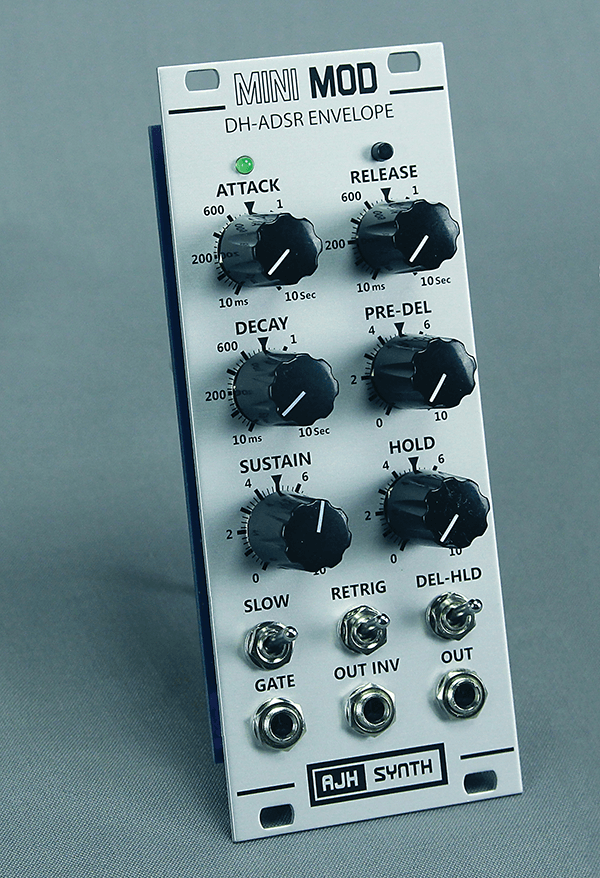
Legendary as the original Minimoog Model D was/is, one area that always undermined it was in the envelope department, where a lack of the now-favoured full ADSR envelope was, in my view, something that always left it lacking – so again, this is another area where AJH have made considerable gains to try and offer both the original envelope designs, as seen in its MiniMod system – and now in this new, improved, full-ADSR design, which brings the MiniMod system bang up-to-date.
On offer here is a single-envelope channel, as opposed to the dual design previously seen, but with far more control and functionality. So much so, it’s likely that if you have a MiniMod system, you’ll want two of these! Starting with the basics, we have a standard ADSR envelope, which has been very carefully engineered to offer the same Moog-like behaviour perviously seen. However, the behaviour feels far more befitting of a contemporary instrument and, simply put, allows complete control previously not seen with the Minimoog. Putting this to one side, there are some other nice new additions, in the shape of a Slow mode, which will slow the ADR phase times down to 20 per cent of normal, and we also have a trigger button and a re-trigger function, which is always a welcome addition to an envelope and will prevent the user from getting RSI, if those repetitive basslines are required.
This is only part of the deal, as the envelope’s ‘DH’ (Delay/Hold) element can be brought into play. The delay aspect is a pre-delay device, which delays the start of commencement of the envelope phase, once the gate is activated, delaying by up to 10 seconds. In addition, the Hold element dictates how long the gate is open for, meaning that single and quick triggers can be given to start a long and unwinding envelope phase. This could be really useful for timbres that might unravel with a single pulse, over a long time frame. Helpfully, the pots are labelled in seconds, meaning that there is a useful point of reference.
All of this stacks up to a very comprehensive envelope, with the final cherry on the cake being the addition of a second output, which is inverted. This is offered for exploitation at the same time as the non-inverted phase.
For anyone who is just looking for a good envelope, this is a feature-rich module to audition. But if you have an existing MiniMod system, this is an absolute must to look at. In my system, I placed it alongside my existing AJH Dual Envelopes, and found the two working really nicely together; but I’m wondering how long it will be before I can resist the temptation of having two of these DH-ADSR modules in my MiniMod rig.
Key Features
- Module width : 10HP
- Module depth : 26mm
- Current usage: 30mA positive, 12mA negative
- Full four-stage ADSR envelope
- Delay/hold phase available
- Inverted output also available
CV Mix – Offset – VCA


In true AJH style, the CV Mixer module is useful on several levels and, while not an obvious module to consider at first sight, might just end up being a Swiss Army Knife for your modular. In the first instance, it’s a four-channel polarising mixer, and without any plugging up, the Input 1 pot can immediately act as a voltage source, making it very useful for creating drones and more. But then as we examine the other three input pots, we find that each one has its own party trick. Input 2 is a regular but useful attenuverter, allowing a signal to be positively or negatively controlled; while input 3 will amplify a CV by two, if you need a little extra CV voltage. Input 4 offers CV offsetting, so when you comp all of this together, a sum can be created for some extreme CV modulation madness, but that’s far from the end of the story. Each of the input pots is calibrated to offer both positive and negative control and as an added bonus, signals are converted from a bipolar +/- signal to a unipolar CV, operating between 0 to +5 volts. This is exceptionally useful in Eurorack, as many modules require a unipolar signal to operate and modulate effectively. So as if all of this weren’t enough, AJH has thrown in a VCA CV, too, which also has the advantage of being DC-coupled.
I think it’s important to stress here how at first glance, this could be one of those utility modules that you think you might not need, but then, as you start to create a complex patch, you find yourself needing a little extra CV control – and it’s in those circumstances that this starts to become indispensable.
It’s is a shame there’s no facility for separate outputs, as that would have been incredibly useful and would allow for use in multiple capacities – but the summing of this module is a thing of joy, and I found myself getting lost in CV modulations that were incredibly complex, thanks to the numerous summing options.
Key Features
- Module width : 10HP
- Module depth : 26mm
- Current usage: 30mA positive, 12mA negative
- Four-channel polarising mixer
- DC-coupled VCA
Alternatives
There is obviously an abundant supply of envelopes and LFOs on the market, but few come up to the quality of the AJH modules. In envelope terms, I’ve always liked the build quality of the Pittsburgh Modular ADSR, which is snappy and well made, but for LFOs, I have always loved the Vermona fourMulator, which although digital in design, has the analogue hands-on feel that you want, with the huge flexibility of being freewheeling or clockable. The CV Mix is the renegade of the bunch, offering far more than most, however, the Mutable Instruments Shades offers similar functionality, but with the ability to separate out CV channels.
V-Scale Variable Buffer

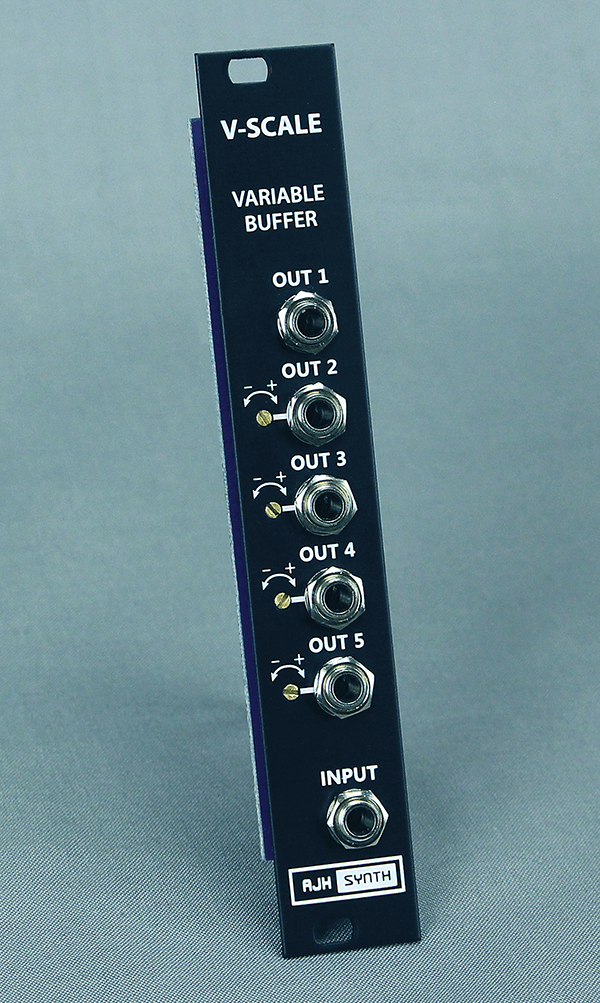
We’ve all had those VCOs that don’t track as well as they might, and although this is often an issue for modules at the cheaper end of the market, it’s not unique to them. I’ve seen issues with quite expensive modules too, so this is where the V-Scale Buffer could be exceptionally useful.
The concept here is to take a pitch CV and run it into the input on the module. Five outputs are then offered: the first being a straight duplicate of the input, but the next four outputs all have a small adjustment screw located next to the corresponding output, meaning that it is possible to add or subtract +/- 5 volt to each output. This will help with the aforementioned modules that just don’t track and might be especially useful if you have a VCF which you’re also trying to track, for the purposes of pitch.
“The summing of this module is a thing of joy, I was lost in complex CV modulations”
It could be argued that the requirement of a jeweller’s-type screwdriver for use here is a little fiddly, and it might have been nice to replace them with small pots, but I can understand why. The small grub screws will offer a much smaller level of adjustment, which is important when calibrating voltages for pitch, but it’s going to be a little fiddly. Therefore, it could mean that you set your offsets to correspond with specific VCOs or VCFs, and doing so would result in a much cheaper solution than having to employ a quantiser to put things right.
There’s no doubt AJH has come up with an incredibly useful module here, and one that, once I saw its purpose, immediately had me smiling and agreeing to myself how useful it would be. Sure, it’s fiddly, but then that’s a small price compared to the annoyance of a VCO playing out of tune.
Key Features
- Module width: 4HP
- Module depth : 26mm
- Current usage: 15mA positive, 15mA negative
- Adjustable- precision active buffer
- Five outputs, of which four are adjustable
Gain SW Multi


The final module in the new AJH lineup is one that will mostly appeal to owners of the MiniMod system. Part of the Moog cloning with the MiniMod was the addition of a jumper on the VCA and VCF modules. This could be removed from the rear circuit board in order to mimc the old Minimoog trick, where the headphone jack was run back into the MiniMoog’s external input, which would in turn create overdrive.
“The Dual LFO and DH-ADSR are outstanding modules and will feel at home in any system”
AJH has listened to its users, who‘ve said they’d like to be able to do this from a front panel, so this nifty little module allows a connection to the jumpers for instant switching to this mode, or off again. With all that additional fascia space, AJH has added a handy six-way multi, which is passive in flavour.
The cables that connect to the AJH MiniMod VCF and VCA are quite short in order to keep noise to a minimum, which does mean this module will have to be situated between them. But you would probably want to do this anyway, even though it will regrettably add 2HP extra to the width of your system.
Key Features
- Module width: 2HP
- Module depth : 26mm
- Current usage: N/A – passive module
- Instant gain switching for MiniMod VCF/VCA owners
The final rack up
What’s particularly impressed me with these modules is the fact that AJH has listened to the requests of its customers and made enhancements and improvements that could not only reside in all Eurorack systems, but also provide a healthy upgrade to some aspects of the existing AJH product line. Granted, certain modules will not appeal to all – but the Dual LFO and DH-ADSR are outstanding modules for any system, and will feel right at home in any Eurorack setting. The CV Mix is an exceptionally useful bit of kit, especially if you have a penchant for summing CVs, which is where it really excels. The V-Scale and Gain Switch look after specific issues and do so excellently, but won’t be for everyone.
Above all, I love the ‘hand made in the UK’ aspect to these new modules, and you can be sure they’ll always come with a reassuring sheen of excellent quality. AJH Synth is gaining huge ground worldwide, with a stunning reputation, and in this strange twilight post-Brexit era in which we reside, I can’t help but feel somewhat delighted and proud for them.
Do I really need this?
If you have a MiniMod system, I think it’s fair to say you’ll probably be drooling at the prospect of adding considerable enhancements to your Moog-esque system. Without doubt, the Dual LFO and DH-ADSR will hugely extend the operation of the original MiniMod system, but don’t overlook the CV Mix, which should end up being a golden ticket of a module, if you happen to be that way inclined. These three modules should appeal to all, in all settings, but the V-Scale could also be hugely indispensable if you are having issues with certain modules and their ability to play in tune. The Gain Switch is great, for what it is, but pointless buying just for the Multi, as there are cheaper Multis elsewhere, and the switches will be redundant without the MiniMod VCF and VCA.
